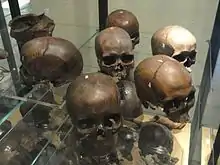Levänluhta
Levänluhta (Finnish: [ˈleʋænˌluhtɑ]; lit. "alga's floodmeadow") or Leväluhta is a spring and prominent archaeological site in the village of Orismala in Isokyrö, Finland. It was used as an Iron Age water burial site from 5th to 8th centuries, containing remains of around 100 individuals.[1] It's one of the oldest known burials in Finland with preserved human bones, as the waterlogged environment had contributed to exceptionally good preservation of the remains.[2]

Remains from Levänluhta at the National Museum of Finland.
Ancient DNA of 13 individuals from Levänluhta has been further studied, revealing that most of them resembled genetically more modern Sami people than Finns, but almost as far.[3][4]
References
- "Lammen vesi värjäytyi punaiseksi ja sieltä nousi ihmisten luita – Levänluhdan vainajia ympäröi mysteeri". Ilta-Sanomat (in Finnish). 13 November 2011. Retrieved 3 December 2018.
- "First ancient DNA from mainland Finland reveals origins of Siberian ancestry in region". Science Daily. 27 November 2011. Retrieved 3 December 2018.
- "Muinais-DNA paljastaa: saamelaisissa ja suomalaisissa on samaa siperialaista perimää" (in Finnish). University of Helsinki. 27 November 2018. Retrieved 3 December 2018.
- Sanni Översti et al. Human mitochondrial DNA lineages in Iron-Age Fennoscandia suggest incipient admixture and eastern introduction of farming-related maternal ancestry, 15 November 2019
External links
This article is issued from Wikipedia. The text is licensed under Creative Commons - Attribution - Sharealike. Additional terms may apply for the media files.